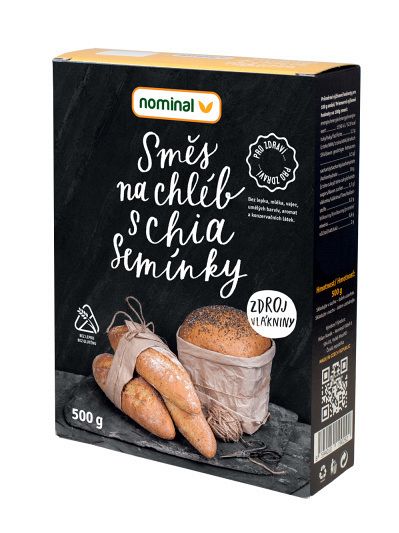Chia seeds contain over 30% fibre in both its soluble and insoluble form. The content of fat is about 30%, a large percentage of which are unsaturated fatty acids. The seeds are also valued for their protein and mineral content. These Salvia hispanica seeds fantastically complement the golden flaxseed flour contained in this mixture and allow you to prepare tasty, supple and gluten-free bread.
|
Ingredients:
Nutritional values in 100 g of mix:
|
Gluten-free wheat starch, millet flour, lupine flour, potato flakes, chia seeds (5%), flaxseed flour, thickener: guar flour, sugar, salt Energy: 1454 kJ/344 kcal; fat: 3 g; USFA: 0.4 g, carbohydrates: 67 g; sugar: 3.5; FIBRE: 9.5 g; protein: 7.5 g; salt: 1.9 g |
Basic Preparation:
- 500 g mixture
- 500 ml(g) water
- 20 ml oil
- 15 g fresh yeast
Baking in home bread maker:
Pour warm water and oil into the bread maker pan, crumble fresh or dried yeast into it, and add the bread mixture. The recommended amount of yeast and water is for gluten-free baking programs with about 45-60 min. rising and about 60 min. baking. The dough should not be mixed any further during rising.
You can adjust the water temperature and amount of yeast according to the type of bread maker and the selected programme length. If the bread coming out of your bread maker is over-proofed (caved in with large uneven pores in the crumb), lower the amount of yeast or use cooler water. If you have the opposite problem, and the bread is under-proofed with possible cracks, use warmer water or add more yeast. You should use a soft spatula to mix the ingredients, which are stuck on the mixing bowl walls, back into the dough. Cut the bread only when it has completely cooled off.
Baking in standard oven:
Mix the dough following the instructions carefully kneading all of the ingredients. Let the well processed dough stand for a moment (about 5 min.), and fill a THOROUGHLY greased form with it. You can shape the dough using slightly oiled palms or on fine buckwheat flour for example. You can cover the formed dough roll with a mixture of seeds as well. The bread form should not be more than 3/5 full. Let rise for 45-60 min. (at 35 °C), and protect from going stale. Bake in a preheated oven at 180 °C for about 50-60 min. Use the conventional heating function.
For baking smaller products (e.g. buns, bread rolls, baguettes or ciabattas), reduce the amount of water in the recipe by about 20 ml. Process the dough as bread. Corrugated baking trays are preferable for baking baguettes. Smaller products rise for about 40 min. Bake those at higher temperatures (up to 220 °C) for about 20-25 min.








